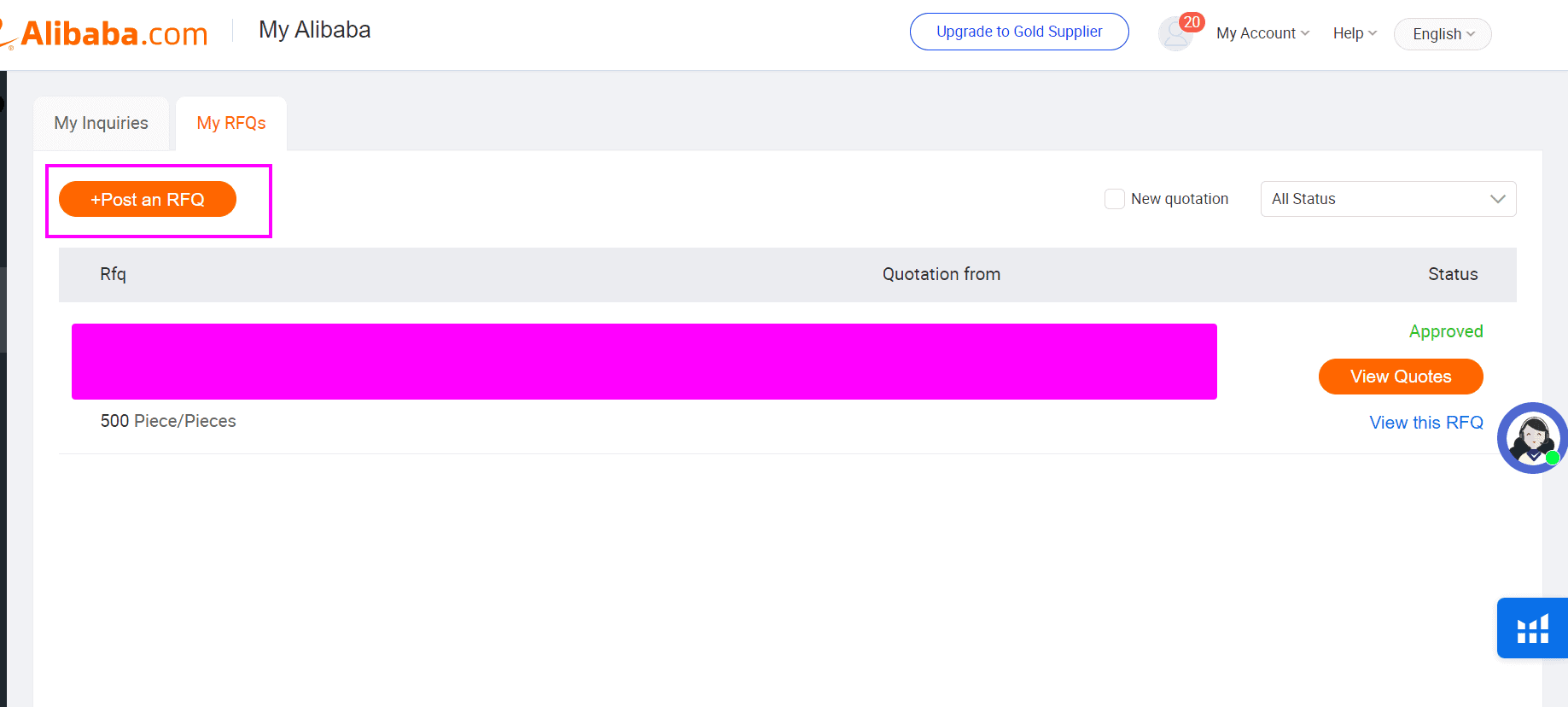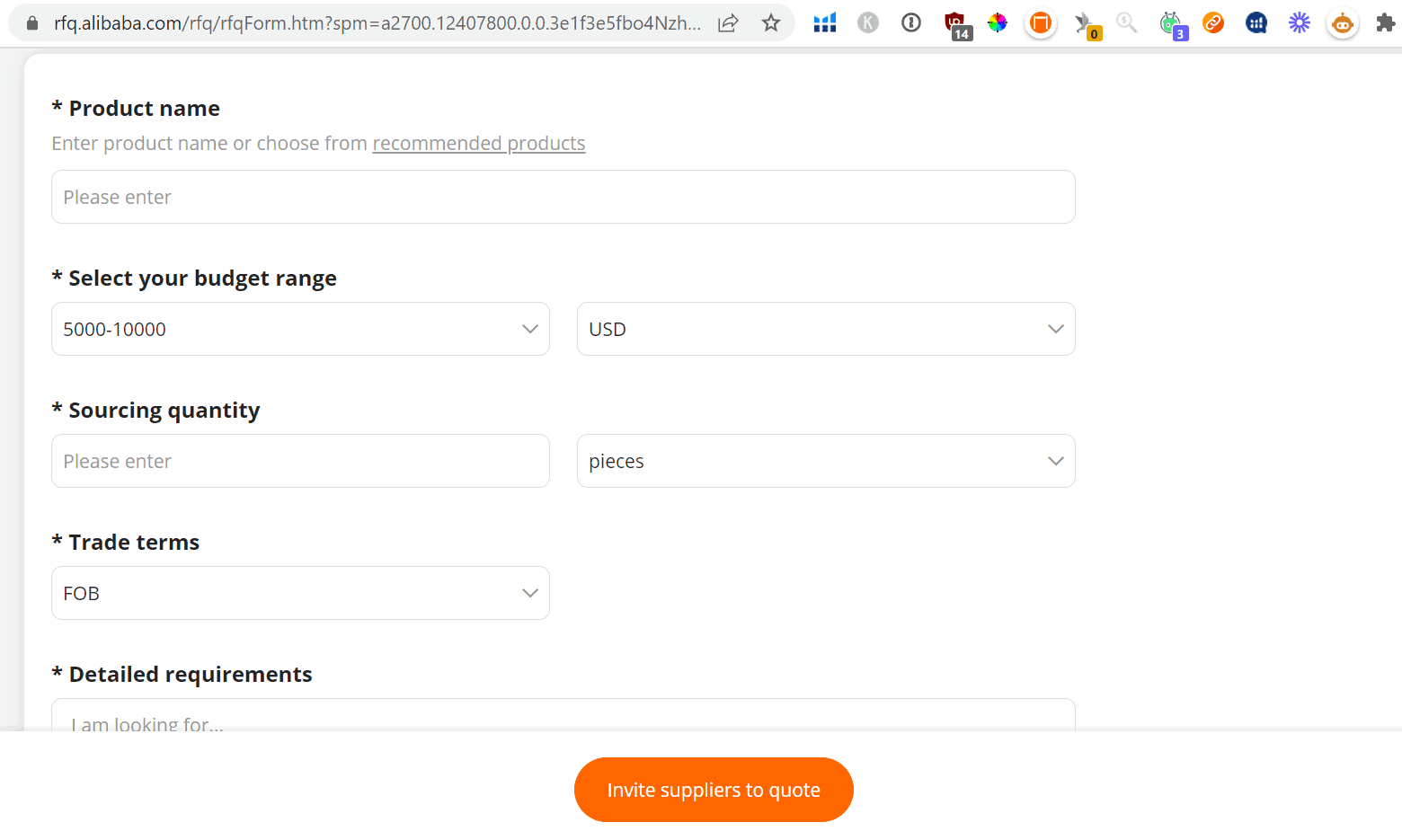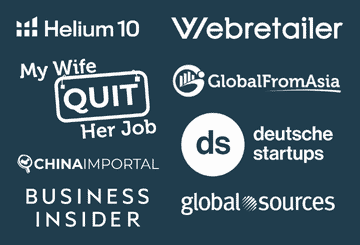Alibaba can be an amazing tool for fulfilling major outsourcing orders, but understanding how the platform works is crucial to get the most out of it. Getting estimates from providers on Alibaba’s platform involves the use of RFQs.
Understanding how Alibaba RFQs work is crucial to getting the most out of what the Alibaba platform has to offer, and the benefits that steady quality outsourcing can bring to your business.
This article will cover:
- What an Alibaba RFQ is and the types of RFQs on platform
- How to create an Alibaba RFQ
- An in-depth but beginner-friendly explanation of how the process works
- Answers to all the major questions beginners have on this topic
Let’s dive in!
What Is an Alibaba RFQ?
RFQ stands for “Request for Quotation” and is a tool for buyers to put out a request for what they need with pertinent details and allow the suppliers on Alibaba to offer quotes to fulfill that order.
This makes an Alibaba RFQ a very handy tool for sourcing goods since the potential providers come to you with quotes, allowing you to compare the costs, reputation of each provider, and to figure out which is best for your specific needs.
I’m a firm believer that a well-written Alibaba RFQ is one of the most important tools to getting the best outsourced products possible.
Types of Alibaba RFQ
There are four types of RFQ on Alibaba, and each one is going to have its own setup for how things work.
The four types of Alibaba RFQs are:
- Invited Bids
- Open Bids
- Sealed Bids
- Reverse Auction RFQs
Let’s take a quick look at each one.
Invited Bid RFQ
An Invited Bid RFQ is one where the buyer (you) invites specific sellers/providers on the platform to bid on the created request.
This is one of my favorite RFQs to use, however it’s one that becomes more useful the more experience you have on the platform as you find favorite providers, or get good recommendations you trust, so you know who to send the invites to.
Open Bid RFQ
An Open Bid is just like it sounds – it’s a bid where any seller can bid openly and check other supplier bids to tailor their pitches accordingly.
This method will get the most bids back to search and is my personal go to whenever I have a product idea but I’m unsure of what type of supplier I need.
The benefits of an open bid RFQ is that you will get plenty of bids from different suppliers. You can then look through the suppliers and find similar options on Alibaba.
Open Bid RFQs allow you to easily find what type of supplier you should be looking for. Be warned though – due diligence is especially important because there are plenty of bids to sift through.
If you have a very clear idea of the product you’d like to manufacture but you’re unsure of the exact supplier/factory that you need – you should use an Open Bid RFQ.
Sealed Bid RFQ
Sealed bids are when you as the buyer make a bid for inventory and send that bid to the suppliers. This is stating the terms for what they can provide and at that point the providers have the option of seeing if it works and responding to see if a deal can be worked out or if they need to counter-offer or reject the terms.
This can be especially useful when you know precisely what you want and what the available budget is.
Reverse Auction RFQ
The reverse auction is an RFQ setup where the bidding from suppliers is open and it’s a simple lowest price seller wins the auction and gets the fulfillment contract.
While this is definitely a budget-conscious option, I’m not the biggest fan of this RFQ because it takes a lot of vetting and quality control out of my hands and opens up more potential for problems.
There is a time and place for each of these four RFQs, however generally speaking most buyers will start with Open Bids and move to a combination of Invited and Sealed Bids over time as they find a number of reliable providers.
Pricing
Basic RFQs on Alibaba can be set up for free. There is a paid RFQ service where the customer can add additional services or required specs for an extra amount. The cost in this case will depend on how many, and what kind of additional services are being requested.
Pro Tip: Most buyers on Alibaba don’t need the paid RFQ option. The free service will more than suffice for your needs.
How Do I Create An Alibaba RFQ?
Creating an Alibaba RFQ doesn’t have to be intimidating. Just follow these easy steps and you’ll have your first RFQ ready for bids in no time!
Requirements
You need to have an account on Alibaba. There’s no upfront cost, just go through the normal steps the site guides you through for setting up an account if you haven’t already done so.
You will also want hard information on hand regarding what you’re ordering. No matter which Alibaba RFQ you go with you will need to list:
- The specific parts (ideally with specification numbers) or detailed descriptions of the parts that are needed
- Total number being ordered
- The level of quality required
- Specific delivery requirements
- Any value-added services you want (if you need
The next steps are easy.
Step 1: Find the RFQ Markets HubTo do this you just sign into your business account on Alibaba. Once you’re in your account click on the “My Account” tab, follow that to “Buying Request Hub,” and then pick the “RFQ Markets” option.

This will get you to where you want to be. If for some reason the interface isn’t showing correctly in your browser, you can try with a different browser or a direct URL: https://rfq.alibaba.com/rfq/exhibition.htm
While this is a bit clunkier, it is a viable work around to get to the right page for creating RFQ orders for your Alibaba account.
Step 2: Search Keywords
On this page look for the RFQ keywords that are commonly used that describe what you need or browse the helpful “Recommended RFQs” so you know you’re clearly getting across what you actually need from the suppliers.
Step 3: Create Your Own RFQ
This is a simple step, on the page you’re looking at all the RFQ Markets options, and assuming you’re logged into your account, you should see a clear Quote Now option. Click on that to create your own RFQ.

This where you fill in all the pertinent details, including the type of RFQ that you are creating on the platform. Once all the details have been filled in, set it live and your RFQ will be public within the Alibaba system.
That’s it. It’s just that easy to create an RFQ on Alibaba and start getting those supplier bids back.
[thrive_leads id=’51377′]
Alibaba RFQ Examples
There are multiple templates for creating an Alibaba RFQ online. There are various formats that some businesses prefer over others, but
Allbusinesstemplates.com has several Alibaba RFQ example templates, and although these are mostly very niche specific templates as opposed to general orders, this can be a good place to brainstorm ideas and see how different RFQ forms can be.
There’s no need to overthink it. The most important thing is to make sure you have all the critical information needed to allow suppliers to give you an accurate RFQ bid.
Your Alibaba RFQ cheat sheet:
- Introduce yourself and your company
- Talk about the specific parts needed with detailed descriptions, and if possible, any identification numbers to the parts or materials if available
- Total number or quantity of parts needed
- Quality of the parts needed including specific quality or testing specifications that must be passed including technical requirements
- Packaging and whether or not it’s included in the RFQ bid
- Requiring them to including information on shipping Incoterm conditions, requirements, and including any additional fees as a result
- Any special delivery requirements that need to be considered
- General timeline
- Requested value-added services
Make sure to include this information or, where appropriate, ask for the suppliers to provide information on questions like packaging and Incoterm fees or conditions.
The RFQ Process on Alibaba
Understanding how the RFQ process works is important, and don’t worry if it takes an order or two to really understand it and have it click. It’s a fairly straightforward process and a little bit of preparation and guidance makes this process easy to understand.
Submit the RFQ
Follow the steps above to create an RFQ, or multiple RFQs, for the materials or supplies that you require to be sourced out to you. There’s obviously no movement without the order being out there, but once an RFQ is in the system the process starts.
Make sure when drawing these documents up that you include all the appropriate information not only to make sure you are getting bids from suppliers on what you need but also so it passes Alibaba’s screening.
Receive Responses
The responses received will obviously vary depending on the type of RFQ that you decided on when putting the order in (Invited, Open, Sealed, Reverse Auction). Examine these responses to compare the supplier offers to your RFQ.
While overall price is an important factor, make sure in contacting these providers that there are no surprise expenses or fees. One bid might seem high but if it includes covering incoterms and additional shipping fees or other expenses and the others don’t, that changes how they all compare to one another.
It shouldn’t take long to get the full number of bids that you’re likely to receive on an open RFQ.
Review & Filter Suppliers
Once you have a number of responses from suppliers, review each of them. Don’t just look at the numbers and details but pay attention to who gave all the requested information and who didn’t. Look up the reputation and rating of suppliers.
This is a good time to filter out suppliers you’re unsure of and compare the best bids from suppliers who are reputable.
Look at all the offers and narrow in on the one that looks like the best fit for that particular RFQ.
Close the RFQ
Once a supplier has been chosen and the deal is hammered out, there’s no reason to keep the request open. Close the fulfilled RFQ and then repeat the process for any additional Alibaba orders you may need in the future.
That’s it. The process is that easy for getting an Alibaba RFQ into the system, bid on, and fulfilled and to get you the supplies needed.
Frequently Asked Questions About RFQ
There are a few important questions that I frequently hear when the topic of the Alibaba RFQ comes up. Here are the most common questions from new users and the answers to each.
Is It Free To Use The Alibaba RFQ Service?
There are two tiers of Alibaba RFQ. The basic RFQ service is free and allows up to 10 bids to be submitted for your order request. This will be a fairly bare bones version of the service and you are allowed to put in 30 of these per month.
Then there’s a paid version that is referred to as Quality RFQ where buyers can add additional requirements or quality services with their needed order. Whether or not this is helpful or needed will vary from buyer to buyer based on individual needs.
What Are The Benefits Of Using The RFQ Service?
There are multiple benefits to outsourcing supplies from Alibaba using their RFQ service. This creates one place, one platform, where orders can be fulfilled and a buyer such as yourself can test out multiple suppliers.
The RFQ Service makes it easy to acquire parts or items in large numbers that a competitor orders or that are necessary for your industry. At the same time, if you are going the creative route to develop new parts or products a detailed RFQ can get multiple bids from those suppliers willing to work with you on a new part or design as opposed to the time consuming process of hitting up one supplier after another and not making progress.
An RFQ service also allows multiple bids so instead of being forced to buy from one supplier who can hike up prices, you can look at multiple proposals and pick out the one that really does work for you and your specific needs.
Is A RFQ Price Legally Binding?
No. While the RFQ price is hopefully as accurate an estimate as possible, and the most reputable suppliers will try to make sure their bid is close based on the information given, prices can change.
The RFQ works as an initial estimate while the legally binding prices come out during the finalization. Price changes can happen for multiple reasons, and you need to watch out for:
- Shipping Incoterms
- Specialized or custom product specifications
- Compliance issues
- Changes to the amount ordered or overall quantity provided
- Exchange rates changes between currencies
- Additional shipping procedures

